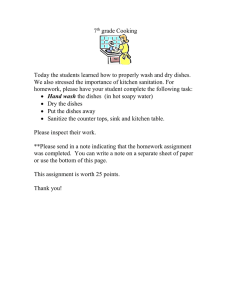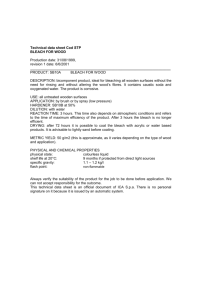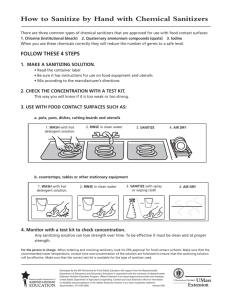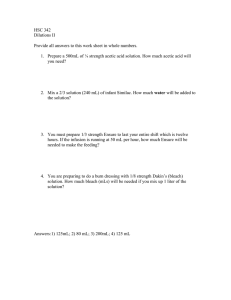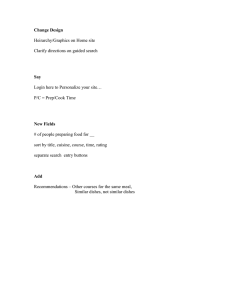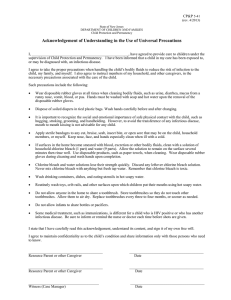Keep Food Safe: Clean, Sanitize, and Disinfect
advertisement
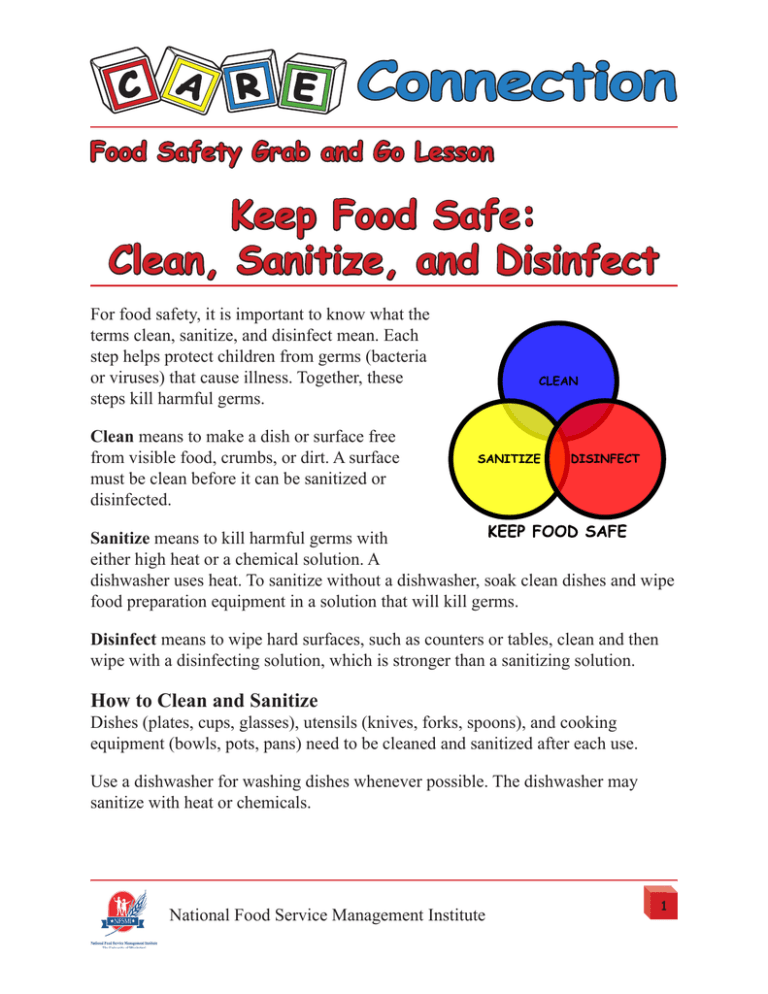
Food Safety Grab and Go Lesson Keep Food Safe: Clean, Sanitize, and Disinfect For food safety, it is important to know what the terms clean, sanitize, and disinfect mean. Each step helps protect children from germs (bacteria or viruses) that cause illness. Together, these steps kill harmful germs. Clean means to make a dish or surface free from visible food, crumbs, or dirt. A surface must be clean before it can be sanitized or disinfected. Sanitize means to kill harmful germs with either high heat or a chemical solution. A dishwasher uses heat. To sanitize without a dishwasher, soak clean dishes and wipe food preparation equipment in a solution that will kill germs. Disinfect means to wipe hard surfaces, such as counters or tables, clean and then wipe with a disinfecting solution, which is stronger than a sanitizing solution. How to Clean and Sanitize Dishes (plates, cups, glasses), utensils (knives, forks, spoons), and cooking equipment (bowls, pots, pans) need to be cleaned and sanitized after each use. Use a dishwasher for washing dishes whenever possible. The dishwasher may sanitize with heat or chemicals. National Food Service Management Institute 1 Food Safety Grab and Go Lesson Keep Food Safe: Clean, Sanitize, and Disinfect If a dishwasher is not available, use a sink with three compartments to wash, rinse, and sanitize dishes. If the sink does not have three compartments, use one or two large dishpans as the second and third compartments. Follow the five steps below. Step 1: Scrape food off surfaces before washing. Step 2: Wash the dishes or equipment in hot, soapy water. Use clean dishcloths each day. Do not use sponges because they can harbor germs. Step 3: Rinse the dishes well in clean hot water, so that no soap is transferred to the chlorine bleach solution in Step 4. Do not mix bleach in with the soapy water. Soap stops bleach from sanitizing. Step 4: Sanitize the dishes by using either the chlorine bleach solution or hot water method. Step 5: Allow the dishes and equipment to air dry. Do not dry with a cloth or towel, as this may spread germs. *Read the label on the bleach bottle: Sodium hypochlorite is the active ingredient in chlorine bleach. Different brands of bleach may have different amounts of this ingredient; the measurements shown below are for bleach that contains 6% to 6.15% sodium hypochlorite. Read the label to find out the concentration of sodium hypochlorite. Chlorine bleach solution method: Soak the dishes for at least one minute in a sanitizing solution*, a mixture of 1 Tablespoon of unscented chlorine bleach + 1 gallon of cool water (hot water stops bleach from sanitizing) Remember to use test strips to check for correct concentrations . Remove dishes from the bleach solution and allow to completely air dry. Check with the local health department for specific requirements. National Food Service Management Institute 2 Food Safety Grab and Go Lesson Keep Food Safe: Clean, Sanitize, and Disinfect Hot water method: Soak the dishes completely covered in 170 °F water for at least 30 seconds. Check the water temperature with a thermometer. Time the soak with a clock. Remove dishes from the hot water and allow to completely air dry. Use gloves or utensils to remove dishes from hot water. How to Clean and Disinfect Hard Surfaces Clean and disinfect food prep area counter tops or work tables, serving counters for meals, and the table and seats after each use. Follow these steps to keep these hard surfaces clean and free from germs. Step 1: Remove food or crumbs. Step 2: Wash with hot, soapy water and rinse with a clean dishcloth. Step 3: Make a disinfecting chlorine solution of ¼ cup of household chlorine bleach mixed with one gallon of warm water. Ask your local Health Department about the requirements for using chlorine test strips to verify the strength of sanitizing solutions. Step 4: Spray surface with solution (use the heavy spray setting) and wipe the surface. Step 5: Allow to air dry. National Food Service Management Institute 3 Food Safety Grab and Go Lesson Keep Food Safe: Clean, Sanitize, and Disinfect There are three chlorine solutions with specific purposes. • Solution 1: Sanitizing food contact surfaces - ¼ teaspoon bleach +1 quart water Solution 2: Sanitizing diapering surfaces including areas contaminated by blood or bodily fluids – 1 tablespoon bleach +1quart water • Solution 3: Sanitizing toys that have had contact with the mouth – 1 teaspoon bleach +1 gallon water Remember! Keep all cleaning products labeled and stored where children cannot get to them. Never store cleaning products near food. Keeping the kitchen and serving areas clean and sanitary is an ongoing job. Train everyone who prepares and serves food to properly clean and sanitize or disinfect all the equipment, dishes, and surfaces that are used. Be sure to follow the local requirements for sanitizing and disinfecting. Check with your sponsor, state agency, or local and state public health department for local requirements. TIP: Check the bleach label for an EPA statement to make sure it will sanitize. New bleaches with fragrance are not sanitizers. *Recommendation from: Graves, D. E., Suitor, C. W., Holt, K. A., Eds. (2012). Making Food Healthy and Safe for Children: How to Meet the National Health and Safety Performance Standards—Guidelines for Out-of-Home Child Care Programs, 2nd Edition. Arlington, VA: National Center for Education in Maternal and Child Health. p. 9. National Food Service Management Institute 4
